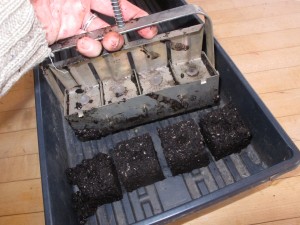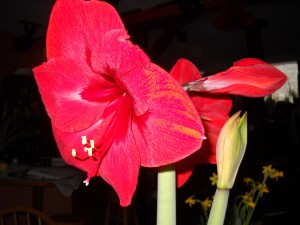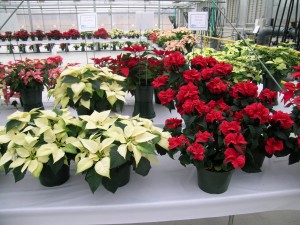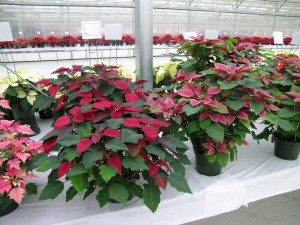Thinking of Spring, Starting a Few Seeds
I’m not sick of winter yet. But I have to admit that recent warm, sunny days got me thinking about spring. I love to start seedlings in the house but recognize that it is still too early for most things. I have a couple of artichoke seedlings growing in a large pot, and will start some onions and peppers by mid-March.
The problem with starting seeds too early is that it is hard to meet the needs of your seedlings until the soil warms up enough to plant them outdoors. I have fluorescent lights and a nice plant stand. But as plants grow, they need bigger pots for their roots. As I start about 300 plants most years, I cannot give each of my babies its own 3- or 4-inch pot after they outgrow the six-packs many of them are started in. The solution? Start most things just six to eight weeks before they go outside – which for tomatoes and other frost sensitive plants is, for me, June 1oth even later.
Most commercial seed starting mixes are made of peat moss, perlite (a fluffy white substance that looks like Styrofoam), and some soluble chemical fertilizer. The assumption is that the mix will get plants off to a good start by providing a fluffy medium for young roots – but that you, the grower, will supply the “food” that your seedlings want after the first month.
After a month the chemical fertilizer will have either washed away or been used up. So what should an organic gardener do? There are fish or seaweed derived liquid fertilizers that you can dilute and add to the water you apply. They will supply the nitrogen, phosphorus and potassium found in a chemical fertilizer, and they will also supply calcium, magnesium, and many other chemical elements needed by your seedlings in small quantities.
Another solution, and one I favor, is to make a 50-50 mix of commercial potting mix with compost. My compost pile is frozen solid, but a good commercial compost such as Moo-Doo will do just fine – it will have healthy microorganisms in it. These bacteria and fungi help to process organic matter and turn it into chemicals that are easily absorbed and used by your seedlings.
Another technique is to make soil blocks using a small metal press that allows you to make 2-inch cubes of a packed soil mixture. This technique is more work, but provides high quality nutrition to your plants, and minimizes root shock when planted outdoors – seedlings grown in plastic six packs usually have tangled roots by the time they go outdoors, but plants started in soil blocks will not.
To make enough mix for about 300 blocs, mix the following ingredients in a wheelbarrow:
10 quarts of dry peat moss
1/4 cup limestone
1 cup azomite or granite dust (optional)
Then add and mix well:
10 quarts coarse sand,
10 quarts of peat humus,
1/2 cup colloidal or rock phosphate
1/2 cup green sand
1/2 cup organic blood meal
Finally add and mix well :
8 quarts of compost (your own or purchased)
8 8 quarts of garden soil or purchased topsoil.
The mix is somewhat dry, and needs to be moistened and used in small batches. For a start, mix 4 quarts of mix with 1-2 quarts of water, stirring it with your hand (wearing a rubber glove). It should be gooey, but firm, not watery. Experiment with it until you find just the right consistency.
To make the blocs, make a pile of the gooey stuff 4-5 inches deep in a recycling bin or other flat-bottomed container. Then compress it by squishing it with the block maker, which makes four 2-inch cubes at a time. Fill up the cavities of the blocker, and then get rid of any excess by pushing the block maker down and rotating it against the bottom of the bin.
You can eject the blocks with the squeeze of the spring-equipped handle into in a standard black plastic flat, which will just hold 32 blocks. Line up the rows of blocs so that they do not touch. Block makers are available from Johnny’s Seeds and the Fedco Seed Company. And if you don’t want to make your own mix, some companies such as Grow Compost of Vermont are making a mix suitable for block makers.
Starting seeds is not for everyone, but I love it. It keeps me from getting squirrely as winter morphs into mud season while waiting for the snow and ice to disappear. Give it a try if you haven’t.
Henry teaches gardening and pruning to groups and individuals. His web site is www.Gardening-Guy.com.
Poinsettias, Amaryllis and Paperwhites, Oh My!
I love to grow things. In fact, I will try growing almost anything once. Indoors, outdoors, elegant, clunky, thorny – every plant has its virtues. I even accepted (against my better judgment) a Crown of Thorns plant (Euphorbia Milii) from my friend and fellow writer, Willem Lange. It was, I believe, a plant from his grandmother – and Will is older than I am. So it might be a 100-year old house plant. It does have nice small reddish flowers (it blooms constantly), but it is tall and lanky and covered with dangerous thorns. I keep it on the deck in the summer where leaves and pine needles fall on it – but I’m afraid to go into the interior regions of this plant to clean them up now, as I might need a blood transfusion after doing the job.
I recently purchased an amaryllis kit at my favorite general store. Amaryllis plants are wonderful: they will produce anywhere from 3 to 9 lovely large lily-like blossoms. They are foolproof if you follow the directions. They come with a soil-like medium, a pot and the bulb. Just hydrate the disk of planting medium (generally coir, a sustainable alternative to peat moss made of shredded coconut fiber) and plant the amaryllis bulb. Half or more of the bulb should be above the soil line in the pot. I like to soak the roots in warm water for 15 minutes before planting to make them more flexible, though the directions don’t tell you to do that. Put on a sunny windowsill and wait. Sometimes an amaryllis bulb will start growing immediately, other times it will sit and sulk for up to a month. (You might want to talk to it, giving it encouraging words if you’re in a hurry). Sometimes it will produce leaves, then flowers – but most commonly the flowers come first. Sometimes you will get just one stalk of flowers, other times 2 or even 3 in sequence. The more you pay for the bulb, generally, the more stems you will get.
Even easier than amaryllis are poinsettias. Every florist and grocery store has them for sale in full bloom right now, ready to adorn your table. Only the “flowers” are not really flowers. They are modified leaves called bracts, which surround an inconspicuous yellow flower in the middle of each cluster. You can get them in a wide variety of colors and shapes. Red is the classic color, and still my favorite, but they also come in pink, cream, striped, peach, cinnamon and more. The key to happy poinsettias is to avoid overwatering them. Only water when the soil feels dry – and when the pot feels light when you pick it up. They do fine in the interior of the house – they don’t need direct sunlight, which may account, in part, for their popularity. You can save them from year to year but the production of the colorful bracts depends on having days of a certain length, which is best done in a greenhouse. And contrary to popular myth, the plants are not poisonous to cats – a University of Ohio team tested them. Poor test kitties, I’m sure they’re not tasty. (I do wonder how they got the cats to eat the poinsettias).
Paperwhite are another sure winner for the holidays, and a great gift for the gardener. These are generally sold as bulbs, not kits, so you have a little more work to do if you’d like these fragrant white blossoms. And it’s too late to get them blooming by Christmas. They generally take a month or more from planting to blooming (for me, anyway). But I shall buy some today, and get started. Paperwhites are in the narcissus or daffodil family. To get them to bloom you will need a flat, wide dish that is an inch or two deep. Fill the dish with gravel or small stones. And although you can pick stones out of your driveway, white stones are available at garden centers in small bags and look much nicer. Simply arrange the bulbs shoulder-to shoulder in the gravel with at least half the bulb sticking up above the layer stones. Then add water until it just kisses the bottom of the bulbs. Do not, I repeat, do not fill the dish with too much water, as you can rot the bulbs. You may need to tie up your paperwhites to keep them from flopping over when the leaves and flower stems get tall. And rotating the dish every few days keeps them from leaning toward the window grasping for more winter light. Paperwhites produce more than one blossom on each stem, and are really quite elegant. They are not re-useable, however. That’s right. After they bloom just throw them away because they are not hardy in New England.
Winter in New England can be bleak. I buy cut flowers at my local florist to keep on the table to brighten the room and remind me of summer. But a few good plants can tide me over during those times when the flowers I’ve bought have gone by, and before I get the next batch. And as to that Crown of Thorns, writing this column inspired me to work on cleaning it up. I used the vacuum cleaner and it worked!
Visit www.henry.homeyer.com to read about Henry’s new children’s book, Wobar and the Quest for the Magic Calumet. It is a fantasy-adventure chapter book about a boy and a cougar.







